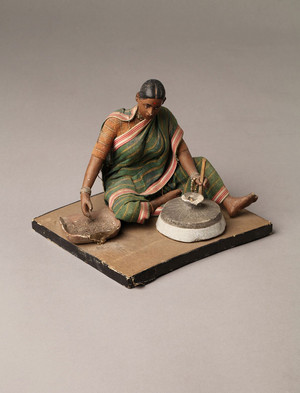Dipika Nadkarni
Indian Handicrafts and Souvenir Production in the 19th century: An Analysis of Objects in Lübeck’s Völkerkundesammlung

Throughout the long nineteenth century, tourists from Europe visited British India and brought back with them souvenir objects that were produced specifically for sale to Europeans. The current pattern of object research in museums focuses on provenance by tracing collector histories and biographies, an approach that often looks at these historic souvenirs as idiosyncratic additions to the enrichment of European intellectual histories. This research attempts instead to look collectively at these objects as representing a system designed to promote Indian handicraft traditions to a European audience, using the objects in the Völkerkundesammlung Lübeck as a case study. Through my research, I challenge notions of inauthenticity of souvenir crafts by exploring the adaptability of indigenous craftsmanship to rapidly mould itself to a widening clientele and changing European taste. By tracing first the development of handicrafts in precolonial India, as well as exploring their role in early colonial knowledge production, my research then investigates the representation and dissemination of Indian crafts in the West.
In the latter half of the nineteenth century, Indian handicrafts were presented as commodities and consumables at the colonial exhibitions that were held in many countries. Starting with the Crystal Palace Exhibition of 1851 in London, Indian handicrafts were placed on a global stage for Europe to witness. In the rush of competitive international colonial exhibitions that followed up until World War I, every major colonial power sought to display the riches, innovations, art, and manufactures of their colonies. These exhibitions presented to their western audience a strong visual representation of life and material culture in the colonies, but also provided a means for the Empire to maintain its position of control. Everyday objects were transformed by removing them from their ordinary contexts and inserting them into these new visual modes.
Through their representation of Indian material culture, these exhibitions also shaped European attitudes towards a constructed and conjectured ideological image of India that served to legitimise the colonial discourse. Yet, collectively, these surviving objects offer us an opportunity to look behind the veil of systems that were designed to promote Indian handicraft traditions to a European audience. For Indian artisans and merchants, these exhibitions meant a whole new clientele and market for their wares; and for the Indian elite, a means to promote a carefully-crafted image of India to the West. This project thus attempts to trace Indian objects in Lübeck not only to contexts of souvenir production as a response to colonialism, but also as they navigate through epistemological spaces between their changing status as traditional crafts, commodities, souvenirs of global tourism, and finally, in the present day, museum artifacts.
Die Lübecker Nachrichten berichteten am 16.02.2022 unter dem Titel "Die rätselhafte Sammlung des Senators" über die Arbeit von Dipika Nadkarni im Völkerkundemuseum.
Am 21.08.2021 sendete das Schleswig-Holstein Magazin einen Beitrag mit dem Titel "Lübeck: Afrikanische Kunst aus zwei Jahrtausenden" mit Dipika Nadkarni. Den Link dazu finden Sie hier. (Der Beitrag ist in der Regel sechs Monate in der Mediathek erreichbar.)
In den Lübeckischen Blättern vom 10.04.2021 gibt Dipika Nadkarni im Beitrag "Sammeln, sichten, ausstellen: Der lange Weg zu einem Völkerkundemuseum in Lübeck" Einblicke in ihre Arbeit. Den Beitrag finden Sie hier.

Dipika Nadkarni completed her Masters in Conservation and Restoration of Archaeological and Museum Objects at Durham University in England (2016 – 2018), with a focus on ethnographic objects and material analysis. She also completed a Masters programme in Numismatics and Archaeology at the University of Mumbai in India (2012 – 2015) with two exchange semesters at the Freie Universität Berlin, and has since worked as a conservator at various museums in Germany and the UK.
Her research project is combined with a scientific traineeship since January 2021 at the Völkerkundesammlung, as part of the “Lübecker Modell”. Her PhD project is supervised by Prof. Dr. Hans Peter Hahn (Goethe Universität Frankfurt).
E-Mail: dipika.nadkarni@uni-luebeck.de
Publications:
- Nadkarni, Dipika: “A Plaster Cast of a Mesopotamian Lioness in the Durham Oriental Museum” in Caple, Chris, and Garlick, Vicky (eds.) Studies in Archaeological Conservation. 1st Edition. Routledge Publishing 2021.
Image ©Völkerkundesammlung der Hansestadt Lübeck